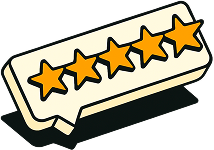How to Choose a Decentralized Exchange for Crypto Trading
Selecting the right DEX crypto exchange can seem daunting, but it doesn't have to be. Start by assessing what you need from a platform. Are you seeking the best Bitcoin trading platform or one that supports a wide variety of cryptocurrencies? Look for decentralized crypto exchanges that offer robust security, user-friendly interfaces, and reliable customer support. A good mix of these features will help you find the ideal platform for your trading requirements.
Trading Fees
Trading fees can significantly affect your overall profitability in the crypto market. It's crucial to compare fees among the leading DEX crypto exchanges to find one that offers competitive rates. Some platforms might have lower trading fees but higher costs for withdrawals or deposits. Evaluating the fee structures of the top decentralized crypto exchanges will help you choose a platform that aligns with your budget and trading strategy.
Available Cryptocurrencies
When choosing a decentralized exchange, consider the range of cryptocurrencies available. The best DEX crypto exchanges should support a wide array of assets, allowing you to diversify your portfolio. Whether you're interested in trading Bitcoin or exploring altcoins, top exchanges typically offer extensive lists of supported assets, ensuring you have the flexibility to invest in the best-performing cryptocurrencies at any time.
Payment Methods
The ease of depositing and withdrawing funds is a critical factor in choosing a decentralized trading platform. Look for DEX crypto exchanges that offer multiple payment methods, such as bank transfers, credit cards, and even PayPal. The more payment options available, the more convenient it will be for you to manage your funds. A versatile payment system is a hallmark of the best decentralized trading platforms, ensuring seamless transactions.
Security
Security should be a top priority when selecting a decentralized exchange. The best DEX crypto exchanges employ advanced security measures, including two-factor authentication (2FA), cold storage, and encryption protocols. These features protect your assets from potential threats and provide peace of mind. A secure platform is undoubtedly crucial, safeguarding your investments against cyber-attacks.
Accessibility
Accessibility is another important factor to consider. The best DEX crypto exchanges should be easy to use, regardless of your location or device. Top platforms offer intuitive mobile apps and responsive websites, ensuring you can trade on the go. Additionally, check if the platform supports your preferred language and complies with local regulations. Accessibility ensures that you can manage your investments efficiently and conveniently.
Liquidity of Crypto Assets
Liquidity is essential for executing trades quickly and at the desired price. The best decentralized exchange should have high trading volumes and a significant number of active users. This ensures that you can buy or sell assets without significant price fluctuations. Top DEX crypto exchanges typically boast high liquidity, making them suitable for both novice and experienced traders. Adequate liquidity guarantees smooth and timely transactions.
Support
Reliable customer support is a vital feature of any leading decentralized exchange. Issues can arise at any time, and having access to responsive support can make a significant difference. Look for DEX crypto exchanges that offer 24/7 customer service through various channels like live chat, email, or phone. Effective support ensures that your problems are resolved quickly, allowing you to focus on trading rather than troubleshooting.
User Interface
A user-friendly interface can greatly enhance your trading experience. The best DEX crypto exchanges offer intuitive and easy-to-navigate platforms, catering to both beginners and advanced users. A well-designed interface allows you to execute trades, monitor your portfolio, and access market data effortlessly. The top decentralized trading platforms prioritize user experience, making it simple for anyone to start trading without a steep learning curve.
Reputation
The reputation of a decentralized exchange is a strong indicator of its reliability and trustworthiness. Research reviews and testimonials to gauge the experiences of other users. The best DEX crypto exchanges are known for their transparency, security, and quality of service. A good reputation often reflects the platform's commitment to providing a safe and efficient trading environment. Choosing a reputable exchange is crucial for ensuring the security and success of your crypto investments.
What is a Decentralized Crypto Exchange?
A Decentralized Crypto Exchange (DEX) is a type of cryptocurrency exchange that operates without a central governing authority, enabling direct peer-to-peer transactions. Unlike traditional exchanges, DEX platforms allow users to retain full control over their funds by facilitating trades directly from their own wallets. This setup not only enhances security by reducing the risk of theft from exchange hacks but also upholds the privacy of its users by eliminating the need for personal information disclosures commonly required by centralized platforms.
The architecture of a DEX is underpinned by blockchain technology, specifically using smart contracts to execute trades automatically and securely without human intervention. These exchanges support a variety of cryptocurrencies and tokens, providing traders with a wide array of trading pairs. The lack of intermediaries in DEXs results in lower transaction fees and often quicker transaction times, appealing to those who value autonomy and cost efficiency in their trading activities. Furthermore, because they are built on blockchain, these platforms are inherently resistant to censorship and external manipulation, aligning closely with the decentralized ethos of the wider cryptocurrency community.
How do decentralized exchanges work?
Decentralized exchanges (DEXs) operate using a distributed network of nodes, ensuring that the platform runs autonomously without a single point of failure or control. This framework is fundamentally different from centralized exchanges, which rely on an organization to oversee operations and manage users' funds.
At the heart of a DEX's functionality are smart contracts-self-executing contracts with the terms of the agreement directly written into code. When a user initiates a trade on a DEX, they interact directly with a smart contract that is programmed to execute the trade under set conditions without any intermediaries. This means that the trade occurs directly between users' wallets. The DEX never takes custody of the funds, thereby reducing risk and enhancing security for its users.
Benefits of Decentralized Crypto Exchanges
- Enhanced Privacy: Users do not need to provide personal information, maintaining anonymity and reducing the risk of data breaches.
- Full Control of Funds: Traders retain complete control over their private keys and assets, mitigating the risk of losses due to exchange hacks.
- Transparent Transactions: All transactions are recorded on the blockchain, ensuring transparency and resistance to manipulation.
- Inclusivity: DEXs are accessible to anyone with an internet connection, bypassing the need for traditional banking systems.
- Access to Innovative Products: They often offer new and unique financial products not available on centralized platforms.
Risks of Decentralized Crypto Exchanges
- Lower Liquidity: DEXs typically have less liquidity than centralized exchanges, leading to higher volatility and potential difficulties in order fulfillment.
- Complex User Experience: The requirement to manage one's own wallet and keys adds complexity, which can be challenging for newcomers.
- Minimal Customer Support: The absence of KYC procedures means very limited customer support, leaving users to manage problems on their own.
- Vulnerability to Bugs: DEXs rely on smart contracts, which can contain bugs or vulnerabilities that may be exploited if not properly audited.
Centralized Exchange vs Decentralized Exchange
In the rapidly evolving world of cryptocurrency, traders have two primary types of cryptocurrency exchanges to choose from: Decentralized Exchanges (DEXs) and Centralized Exchanges (CEXs). Each type offers distinct advantages and caters to different user needs and preferences, from security and privacy to user experience and liquidity. Understanding the fundamental differences between DEXs and CEXs is crucial for anyone involved in crypto trading, as it directly impacts the control over their assets, the level of privacy maintained, and the efficiency of their transactions. This comparison seeks to delineate the key contrasts between decentralized and centralized platforms, helping traders make informed decisions based on their individual trading goals and requirements.
Custody of Assets
A primary distinction between decentralized exchanges (DEXs) and centralized exchanges (CEXs) lies in the custody of assets. In a DEX, users retain control of their private keys and thus their assets, conducting transactions directly from their personal wallets. This model enhances security as the exchange itself does not hold user funds, reducing the risk of hacks and theft. Conversely, CEXs take custody of user funds, holding them in company-controlled wallets. While this can simplify trading and provide additional services like recovery of lost passwords, it also introduces risks if the exchange's security is compromised.
Anonymity and Privacy
DEXs typically require no personal information from their users, offering a higher degree of anonymity and privacy. Transactions on a DEX do not involve submitting sensitive personal data, which appeals to users concerned about privacy and those in restrictive jurisdictions. On the other hand, CEXs usually require users to undergo identity verification processes (Know Your Customer, or KYC) to comply with regulatory requirements, which involves sharing personal information and documentation.
Trading Volume and Liquidity
Centralized exchanges (CEXs) offer significant advantages for day traders, primarily due to their high trading volumes and strong liquidity. This setup allows for fast and efficient trade execution, which is crucial when choosing a crypto day trading exchange, where quick response to market fluctuations can dramatically impact profitability. On the flip side, decentralized exchanges (DEXs) are improving but generally face challenges with lower liquidity, leading to higher slippage and less favorable pricing for large volume trades - factors that can deter day traders who depend on swift and precise order execution.
User Experience and Features
Centralized exchanges (CEXs) typically offer a user-friendly interface, enhancing the trading experience with features like margin trading, stop loss orders, and futures. These additions make CEXs particularly appealing for beginners or those looking to delve into crypto margin trading exchanges. Moreover, CEXs provide robust customer support services to help users navigate the platform and resolve any issues they may encounter. In contrast, decentralized exchanges (DEXs) prioritize secure, peer-to-peer transactions, but often present a steeper learning curve with fewer trading options. This focus on fundamental functionality appeals to those who value security and direct control over their trades including the shorts on crypto.
Regulatory Compliance and Security
CEXs are usually subject to financial regulations, which can provide a layer of security and reliability through oversight but also impose certain restrictions and requirements on users. Regulatory compliance can make CEXs appear more trustworthy to some users, potentially leading to wider adoption. DEXs operate with minimal regulatory oversight, aligning with the decentralized ethos of the crypto community but also possibly increasing the risk for users in terms of legal protection and recourse.
How to Get Started with a Decentralized Cryptocurrency Exchange (DEX)
Signing up and starting to trade on a decentralized exchange (DEX) typically involves a few key steps that differ significantly from those on a centralized platform. Here’s a simplified guide:
- Create a Wallet: Instead of creating an account, you'll need a compatible cryptocurrency wallet. This wallet will directly interact with the DEX, allowing you to manage and trade your assets securely without surrendering control to a third party.
- Connect Your Wallet: Connect your wallet to the DEX. This usually involves visiting the DEX’s website and selecting the connect wallet option. You maintain control of your keys, and thus your funds, at all times.
- Start Trading: With your wallet connected, you can immediately begin trading. There’s no need for identity verification or personal information, aligning with the ethos of privacy and decentralization.
DEX Crypto Exchange Fees
When using a DEX, it's important to understand the fee structure, as it can influence your trading decisions. We recommend using one of the BTC exchanges with the lowest fees.
Trading Fees
DEXs typically charge a fee for each transaction. These fees are used to compensate liquidity providers who supply the assets that make trades possible. Unlike centralized exchanges, there are usually no different rates for makers and takers.
Network Fees
You'll also encounter network fees, which are paid to blockchain miners or validators to process your transactions. These fees vary depending on the blockchain used and the current network congestion.
Withdrawal Considerations
Since you trade directly from your wallet, traditional withdrawal fees from a platform do not apply. However, moving your crypto to different wallets or exchanges will incur network fees.
Decentralized exchanges offer a unique trading experience focused on user autonomy and privacy. By understanding these differences, especially in the fee structure and account setup, you can better navigate the world of DEXs and optimize your trading strategy.
FAQ: Decentralized Crypto Exchange Platforms
Are decentralized exchanges legal?
Yes, decentralized exchanges are legal in most jurisdictions. However, the specific legality can depend on local laws and regulations regarding cryptocurrency. Users should verify the legal status in their own country before using a DEX.
Are decentralized exchanges safe?
Decentralized exchanges offer a high level of security because they allow trading without giving up control of your private keys. However, they still require users to practice good security habits, such as safeguarding wallet keys, to prevent loss or theft.
How do decentralized exchanges make money?
Decentralized exchanges typically earn revenue through trading fees. These fees are charged as a percentage of each trade and are used to compensate liquidity providers and for the ongoing development and maintenance of the platform.
Which is safer, a DEX or a CEX?
DEXs are generally considered safer in terms of risk of theft from hacking, as they do not hold user funds. However, CEXs offer added security measures like customer support and compliance with regulatory standards, which can be beneficial depending on user needs.
Do decentralized exchanges report to the IRS?
As decentralized platforms, DEXs do not typically collect user information and therefore do not directly report to tax authorities like the IRS. It is the user’s responsibility to report and pay taxes on any transactions as required by their local laws.
Do I need to pay tax on decentralized exchange transactions?
Yes, in most jurisdictions, transactions on decentralized exchanges are subject to tax just like those on centralized exchanges. Users are responsible for keeping records of their transactions and reporting any gains or losses on their tax returns.
What should I look for in a decentralized exchange?
When choosing a DEX, consider factors like security features, supported assets, liquidity, fee structure, and ease of use. It’s also wise to research the exchange’s development team and read user reviews to gauge reliability and performance.
Can I trade any cryptocurrency on a decentralized exchange?
While DEXs support a wide range of cryptocurrencies, they may not support every asset. Availability depends on the specific DEX and the liquidity provided for each asset. Always check if the cryptocurrency you’re interested in is available on the exchange you plan to use.
Conclusion: The Best Crypto and Bitcoin Decentralized Exchanges Ranked by Bitcoin.com
Selecting the right decentralized crypto exchange is vital for effective trading. Top choices like Verse Dex, KuCoin, Bitget, Binance and Exolix excel in security, range of cryptocurrencies, and user experience. Bitcoin.com regularly updates its rankings, ensuring you have the latest information on the best platforms to meet your trading needs.
Business & Partnership Enquires
For business or partnership queries, please contact us through affiliates@bitcoin.com. Our marketing experts will assist you as soon as possible.





















